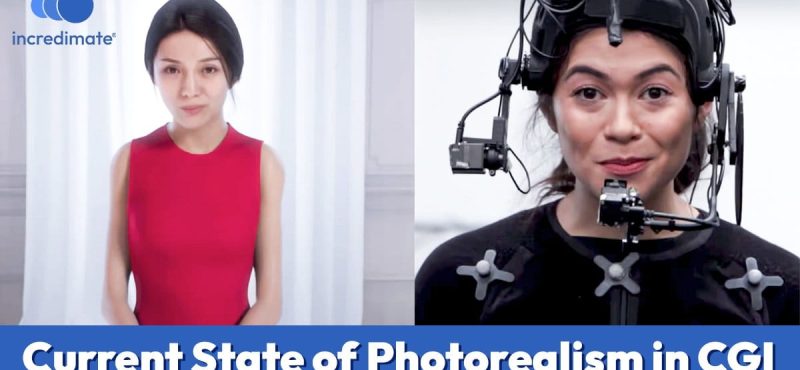Greetings, fellow CGI enthusiasts! Welcome to Incredimate Studio, where we proudly proclaim ourselves as India’s best 3D animation studio in India. Today, we’re diving headfirst into the fascinating world of photorealism in CGI (Computer-Generated Imagery). Brace yourselves for a wild ride through the cutting-edge techniques and mind-boggling advancements that are blurring the lines between reality and digital wizardry. Prepare to be amazed, amused, and perhaps slightly confused (but in the best possible way, of course).
In a world where visual experiences are becoming increasingly immersive and lifelike, the demand for photorealistic CGI has skyrocketed across various industries, from blockbuster movies and video games to advertising and architectural visualization. Thanks to groundbreaking advancements in technology and techniques, the current state of photorealism in CGI has reached unprecedented levels, pushing the boundaries of what was once thought impossible and leaving audiences in awe of the digital magic unfolding before their eyes.
Techniques like path tracing, photon mapping, and global illumination algorithms have taken realistic lighting and rendering to dizzying new heights, capturing the intricate interplay of light and shadow with jaw-dropping accuracy.
Improved Material and Texture Fidelity
Physically based rendering (PBR) has become the industry standard, ensuring that digital materials behave and interact with light in a way that mimics their real-world counterparts, resulting in textures and surfaces that are so realistic, that you’ll be tempted to reach out and touch them (but please don’t, that would be weird).
Advancements in texture scanning and generation techniques have given rise to mind-bogglingly detailed and accurate textures, capturing even the most intricate patterns and imperfections found in real-world materials.
And let’s not forget about subsurface scattering algorithms, which have taken the rendering of translucent materials like skin, wax, and certain types of plastic to a whole new level of realism, giving CGI characters a lifelike quality that was once the stuff of science fiction.
Advancements in Modeling and Sculpting
High-resolution 3D scanning and 3d photogrammetry techniques have revolutionized the way digital models are created, allowing artists to capture real-world objects and environments with such incredible accuracy that you’ll be hard-pressed to tell the difference between the digital and the tangible.
Powerful sculpting tools and algorithms have opened up a world of possibilities for creating intricate organic shapes and surfaces, enabling artists to craft highly detailed and realistic CGI models and environments that mimic the complexity and beauty of nature itself.
Advancements in Facial and Character Animation
Motion capture and performance capture technologies have taken CGI character animation to new heights, allowing digital characters to exhibit facial expressions, body language, and movements that are so realistic, that you’ll be tempted to strike up a conversation with them (but please don’t, that would be a whole new level of weird).
Deep learning and neural networks have ushered in a new era of digital humans and facial animations, enabling artists to create highly realistic digital characters based on captured performances, blurring the line between reality and CGI even further.
Realistic Simulations and Dynamics
A. Particle systems, fluid simulations, and physics engines have become so advanced that they can now simulate natural phenomena like smoke, fire, water, cloth, and hair with mind-boggling realism, bringing digital worlds to life in once inconceivable ways.
Procedural modeling and simulation techniques have enabled the creation of highly detailed and realistic environments, from vast and intricate landscapes to bustling urban environments teeming with life and activity.
Seamless Integration of CGI and Live-Action
Advancements in compositing techniques and tools have made it possible to seamlessly blend CGI elements with live-action footage, creating a seamless and immersive experience that blurs the line between reality and digital artifice.
Motion tracking and camera tracking algorithms have become so precise that they can accurately integrate Computer Generated Imagery elements into live-action scenes, ensuring that they move and interact with their surroundings in a way that feels completely natural and believable.
Challenges and Limitations
Despite the incredible advancements in photorealistic CGI, computational power and render times remain a significant challenge, often requiring massive amounts of processing power and specialized hardware to achieve the desired level of realism.
The dreaded “uncanny valley” – that unsettling feeling you get when something looks almost, but not quite, human – is a constant hurdle that digital artists must overcome in their pursuit of absolute realism.
The need for constant innovation and research is paramount, as the bar for photorealism in CGI continues to be raised, pushing artists and technologists to constantly explore new techniques and technologies to stay ahead of the curve.
Future Developments and Prospects
Potential advancements in hardware and software, such as faster and more powerful graphics processing units (GPUs) and more efficient rendering algorithms, could pave the way for even more realistic and immersive CGI experiences.
The role of artificial intelligence and machine learning in CGI is becoming increasingly important, with these technologies being used to enhance everything from texture generation and material simulation to character animation and rendering.
Conclusion
Recap the current state of photorealism in CGI: The current state of photorealism in CGI is nothing short of awe-inspiring, with cutting-edge techniques and technologies enabling digital artists to create visual experiences virtually indistinguishable from reality.
Emphasize the continuous pursuit of greater realism: However, the pursuit of even greater realism in CGI is a never-ending journey, driven by the relentless curiosity and creativity of digital artists and technologists who are constantly pushing the boundaries of what is possible.
Frequently Asked Questions
Some of the key techniques include path tracing, photon mapping, global illumination algorithms for realistic lighting and rendering, physically-based rendering (PBR) for accurate material behavior, subsurface scattering for translucent materials like skin, and advanced texture scanning/generation methods.
High-resolution 3D scanning, photogrammetry, and powerful sculpting tools have enabled artists to capture and create highly detailed, organic shapes and surfaces that mimic the complexity of real-world objects and environments.
Motion capture and performance capture technologies allow digital characters to exhibit realistic facial expressions, body language, and movements based on captured performances from real actors or performers.
These advanced simulations and dynamics can now recreate natural phenomena like smoke, fire, water, cloth, and hair with incredible realism, bringing digital worlds to life in once inconceivable ways.
Significant computational power and long render times are still major challenges, as is overcoming the “uncanny valley” effect when creating near-human CGI. Constant innovation and research are also required to keep pushing the boundaries of realism.








